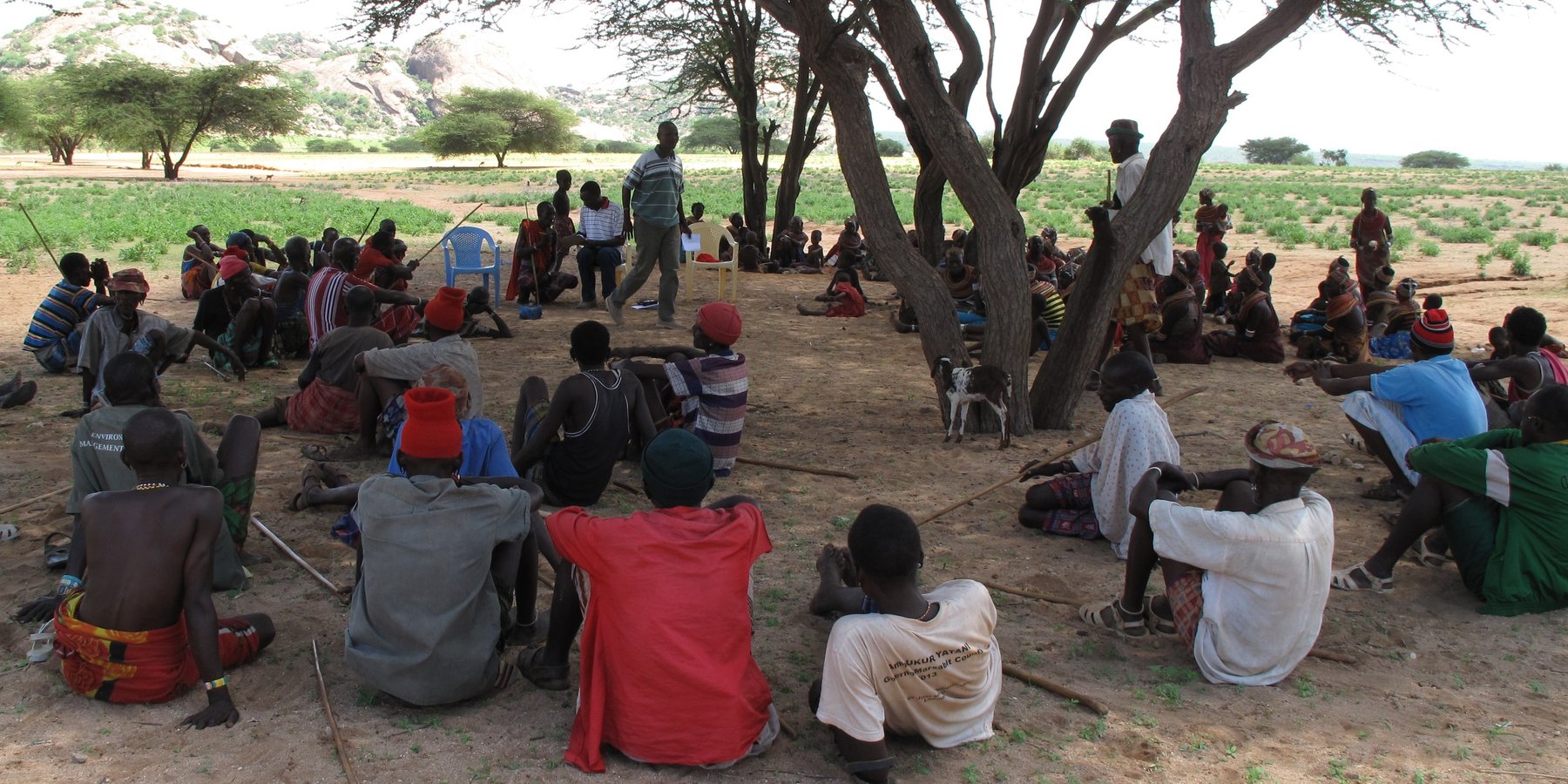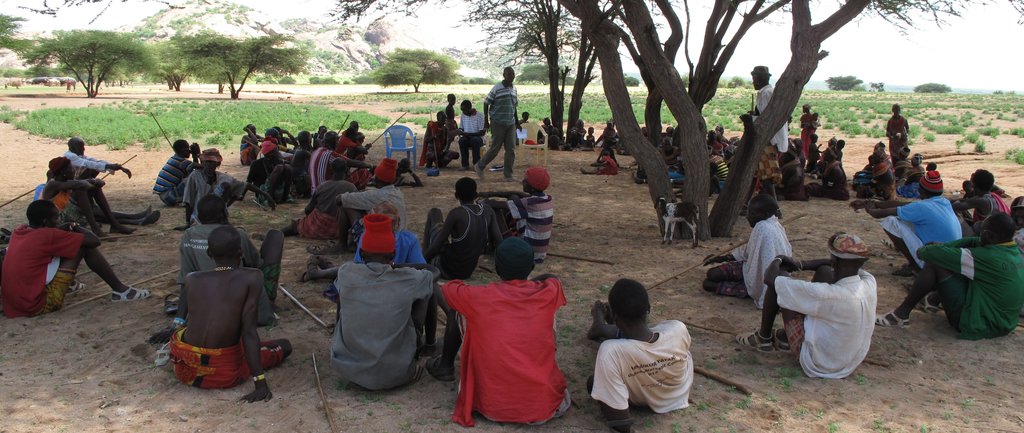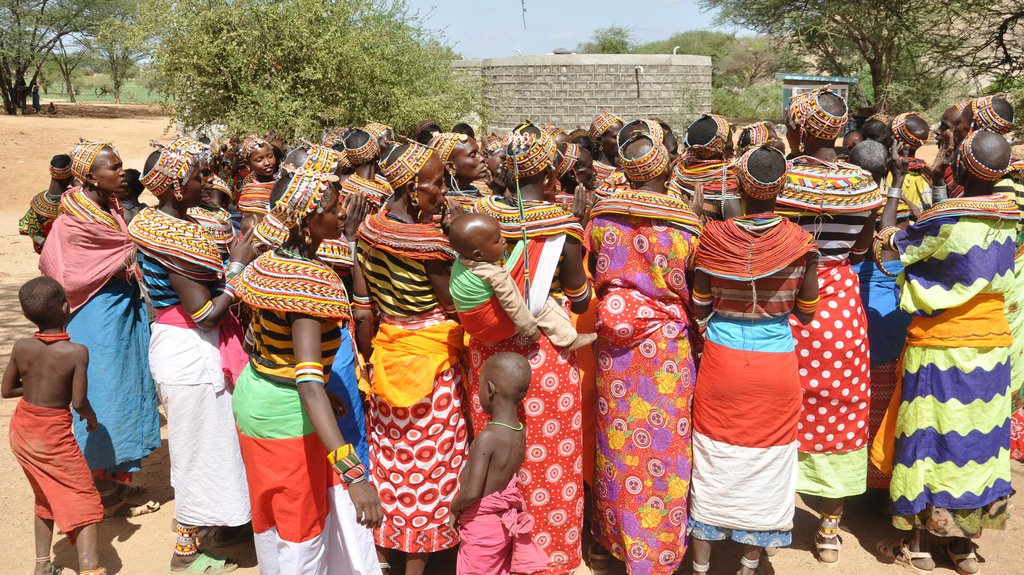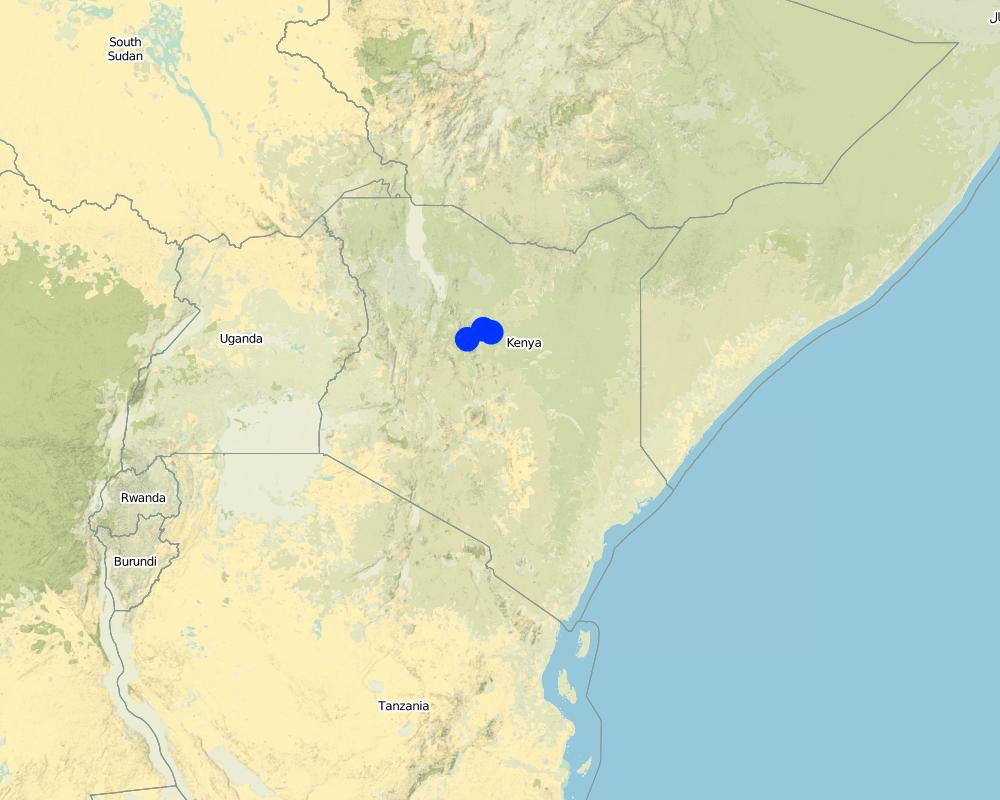Partnership with beneficiary communities in project implementation [Quênia]
- Criação:
- Atualização:
- Compilador/a: Fredrick Ochieng
- Editores: Nicole Stolz, Boris Orlowsky
- Revisores: Alexandra Gavilano, Boris Orlowsky, Renate Fleiner
N/A
approaches_597 - Quênia
Veja as seções
Expandir tudo Recolher tudo1. Informação geral
1.2 Detalhes do contato das pessoas capacitadas e instituições envolvidas na avaliação e documentação da abordagem
Pessoa(s) capacitada(s)
Fredrick Ochieng:
Quênia
Nome do projeto que facilitou a documentação/avaliação da Abordagem (se relevante)
Book project: where people and their land are safer - A Compendium of Good Practices in Disaster Risk Reduction (DRR) (where people and their land are safer)Nome da(s) instituição(ões) que facilitou(ram) a documentação/avaliação da Abordagem (se relevante)
CARITAS (Switzerland) - Suíça1.3 Condições em relação ao uso da informação documentada através de WOCAT
Quando os dados foram compilados (no campo)?
14/10/2016
O/a compilador/a e a(s) pessoa(s) capacitada(s) aceitam as condições relativas ao uso de dados documentados através da WOCAT:
Sim
1.4 Referência ao(s) questionário(s) sobre tecnologias da GST

Rock catchment [Quênia]
A rock catchment system is a water harvesting structure comprising a bare sloping rock surface (impounded area), a constructed concrete wall at a strategic point (weir), pipeline from the weir to the storage tank(s), storage tanks and water kiosk(s) connected to the water tanks by pipelines.
- Compilador/a: Fredrick Ochieng
2. Descrição da abordagem de GST
2.1 Descrição curta da abordagem
The approach focuses on community engagement on a partnership basis. The model is a departure from the traditional approaches where the community mostly is reduced to being a beneficiary of project services without substantive responsibility.
2.2 Descrição detalhada da abordagem
Descrição detalhada da abordagem:
The Approach is hinged on community empowerment and partnership. The model is a departure from the traditional approaches where the community is reduced to a mere beneficiary of project services without substantive responsibility.
The main purpose of the approach is to enhance ownership, while fostering needed capacity for management of project outcomes. Ultimately, it is estimated that sustainability of project results is achievable with good community empowerment and meaningful participation. The approach also aims at cost effectiveness as the community is required to substantially contribute locally available materials, labour and sometimes cash.
Community mobilisation and capacity building is central to ensure that the community is prepared to undertake their roles and responsibilities. Mobilisation happens through discussions, sometimes aided by applying participatory tools and methods. Capacity building is done through workshop-type and/or on-the-job training. It is noteworthy that the communities do have indigenous knowledge and skills which are useful in processes of development at the community level. These skills and knowledge inform the project design, planning and implementation of activities. To enhance local skills, selected community members are trained as they work alongside the hired skilled artisans during the construction of the rock catchment system. The aim is to prepare and equip the locals with basic skills for operations and maintenance of the rock catchment system. Others are trained to get equipped with skills on hygiene and sanitation promotion.
The project was designed based on pre-project assessment. The assessment, besides identifying water and hygiene needs, also identified three areas/communities which had rock catchment potential - Ndikir, Manyatta Lengima and Mpagas. Initial meetings were done with support from community leaders and the local government administrators (chiefs). During the meetings the project was explained and discussed in view of the community needs and the roles for all stakeholders - Caritas Switzerland (CACH), the community, government and leaders. Agreed roles and responsibilities were drafted and formed the main part of the memorandum of understanding (MOU) between CACH and the community. The MOU was signed before the entire community for collective ownership and formalise the relationship between CACH and the project.
At the county and sub-county level, the stakeholders are provided with progress updates, engaging with government and other leaders. The local leaders were useful in helping in community mobilisation and addressing areas of concern wherever issues arose.
The approach left the community more motivated with a desire to manage the project benefits for posterity. The community has appreciated that the project ended with a number of community members having acquired basic skills for operations and maintenance. Above all, they were proud that they significantly contributed to the successful implementation of the project. Initially the community were opposed to the idea that they had to contribute so much, since before they had mostly received assistance without any requirement on their side to contribute.
2.3 Fotos da abordagem
2.4 Vídeos da abordagem
Comentários, breve descrição:
The video is taken on an early morning shower and shows how water is collected, dammed and channelled downstream to the masonry tanks.
Data:
08/12/2014
Localização:
Ndikir village, Marsabit County, Kenya
Nome do cinegrafista:
Fredrick Ochieng
2.5 País/região/locais onde a abordagem foi aplicada
País:
Quênia
Região/Estado/Província:
Laisamis sub county, Marsabit County, Kenya
Especificação adicional de localização:
Implemented with three different communities in three locations, Ndikir, Manyatta Lengima and Mpagas
Map
×2.6 Datas de início e término da abordagem
Indique o ano de início:
2013
Ano de término (caso a abordagem não seja mais aplicada):
2015
Comentários:
The Rock catchment project was implemented from 2013 to 2015
2.7 Tipo de abordagem
- Baseado em projeto/programa
2.8 Principais metas/objetivos da abordagem
1. Community mobilisation
2. Active community participation and ownership of the project and outcomes
3. Sustainability of the project outcomes
4. Enhanced skills and capacity to manage the Technology
2.9 Condição que propiciam ou inibem a implementação de tecnologia/tecnologias aplicada(s) segundo a abordagem
Normas e valores sociais/culturais/religiosos
- Inibitivo
The community was accustomed to receiving food and non-food handouts. This culture was a major huddle in working with community where they were expected to make substantial contribution towards the project activities.
Quadro institucional
- Propício
The institutional setting, especially the traditional authority of elders, was supportive during implementation. Once the elders were convinced and persuaded to make certain decisions beneficial to the project, it was always easier for the rest of the community members to rally behind.
Colaboração/coordenção de atores
- Propício
The Approach requires that stakeholders (other non-state actors and government) coordinate well so that approaches employed by all are complementary and all build into sustainable results. It is common however that there have been approaches that dis-empower communities. Good coordination and collaboration would enhance sharing and learning across the actors and minimise such programming pitfalls.
Quadro jurídico (posse de terra, direitos de uso da terra e da água)
- Propício
Land tenure in the northern Kenya is mostly communal. This was an enabling factor so that there were no complex and usual elaborate and expensive legal requirements to construct a rock catchment water system. Had land been adjudicated and subdivided for individual ownership, there would have been a need for negotiations and legal procedures to be done with those who own the land where the public asset is to be located.
3. Participação e papel das partes interessadas envolvidas
3.1 Partes interessadas envolvidas na abordagem e seus papéis
- Usuários de terra/comunidades locais
The project was implemented with participation of the communities who are the local land users
Community's role was to ensure that locally available materials were delivered on the site of construction, hygiene and sanitation promotion, unskilled labour, record keeping of all construction materials, security of workers and construction materials on site
- Especialistas em GST/ consultor agrícola
Caritas had a technical team of three staff who were based within the project location in the field. This team was supported through experts in the office in the capital city Nairobi.
The technical team implemented all project activities such as community organisation/mobilisation, construction of infrastructure as well as hygiene and sanitation promotion.
- Governo local
Chiefs, Members of County Assembly, Ward administrators
Opinion leaders were critical in the process of community mobilisation and following-up the commitments made by the community under the signed MoU.
- Governo nacional (planejadores, responsáveis pelas decisões)
County Steering Group (CSG), sub-County Steering Group (SCSG)
Coordination with other development agencies and government departments at the County level
- Organização internacional
Caritas Switzerland
Overall leadership in project planning, implementation and supervision
3.2 Envolvimento do usuários de terra/comunidades locais nas diferentes fases da abordagem
| Envolvimento do usuários de terra/comunidades locais | Especifique quem estava envolvido e descreva as atividades | |
|---|---|---|
| Iniciação/motivação | Participativo | Planning for project activities was jointly planned between the community and the project staff specialists |
| Planejamento | Participativo | More technical planning was done as advised by the technical project team. Planning for day to day field activities during implementation was jointly done with the community |
| Implementação | Participativo | Community participation was more interactive in planning for specific project activities. However, there were specific tasks which required hired labour and by common agreement the community provided such labour for payment. |
| Monitoramento/avaliação | Participativo | Monitoring with community was mainly done during project reflection/review meetings. Monitoring in this respect was more limited to evaluation of project activities progress and timeliness with which the activities were being achieved. |
3.3 Fluxograma (se disponível)
Descrição:
The flow chart summarises the Approach's key components, activities and steps for community mobilisation, capacity building and stakeholders engagement. The stakeholders include the relevant government departments - Water, Health, Environment, Drought Management - and non-state actors in the County. There is a monthly forum known as the County Steering Group (CSG) which brings together all the heads of government departments and NGO representatives at the county level. Similar forums also take place at the sub-county level.
Autor:
Fredrick Ochieng
3.4 Decisão sobre a seleção de tecnologia/tecnologias de GST
Especifique quem decidiu sobre a seleção de tecnologia/tecnologias a serem implementadas:
- todos os atores relevantes, como parte de uma abordagem participativa
Explique:
The project was designed initially without direct community involvement other than the pre-project information collected.
Especifique em que base foram tomadas as decisões:
- Avaliação de conhecimento bem documentado de GST (tomada de decisão baseada em evidências)
- Resultados de pesquisa
- Experiência pessoal e opiniões (não documentado)
- Government policies
4. Suporte técnico, reforço das capacidades e gestão do conhecimento
4.1 Reforço das capacidades/ formação
Foi oferecida formação aos usuários da terra/outras partes interessadas?
Sim
Especifique quem foi capacitado:
- Usuários de terra
- Equipe de campo/consultores
Tipo de formação:
- Em exercício
- Áreas de demonstração
Assuntos abordados:
Basic construction skills, management of water system (rock catchment), hygiene and sanitation promotion
4.2 Serviço de consultoria
Os usuários de terra têm acesso a um serviço de consultoria?
Sim
Especifique se foi oferecido serviço de consultoria:
- nas áreas dos usuários da terra
Descreva/comentários:
The community has (in theory) access to government advisory services. However, the nearest government offices are about 20-50 kilometres away without reliable means of transport. The technical staff of the county government is often unable to offer quality and effective extension work, mostly due to transport limitations but also due to low motivation. However, this gap is being bridged through the work of various NGOs operating in the region who provide advisory services in addition to other interventions such as in water, health, livelihoods, and education.
4.3 Fortalecimento da instituição (desenvolvimento organizacional)
As instituições foram fortalecidas ou estabelecidas através da abordagem?
- Sim, moderadamente
Especifique a que nível (níveis) as instituições foram fortalecidas ou estabelecidas:
- Local
Descreva instituição, papéis e responsabilidades, membros, etc.
The Approach led to establishment of Water Management Committees. The committees have been trained and equipped to manage the systems.
Especifique o tipo de apoio:
- Financeiro
- Reforço das capacidades/ formação
- Equipamento
Dê mais detalhes:
One key lesson from this and other projects is that one-off trainings are rarely effective even if properly done. A continuous support/follow-up is necessary to maintain the skills and knowledge acquired.
4.4 Monitoramento e avaliação
Monitoramento e avaliação são partes da abordagem?
Não
4.5 Pesquisa
A pesquisa foi parte da abordagem?
Não
5. Financiamento e apoio material externo
5.1 Orçamento anual para o componente de GST da abordagem
Caso o orçamento exato seja desconhecido, indique a faixa:
- 2.000-10.000
Comentários (p. ex. principais fontes de recursos/principais doadores):
Internal organisational funding and external donors
5.2 Apoio financeiro/material concedido aos usuários da terra
Os usuários da terra receberam apoio financeiro/material para a implementação de tecnologia/tecnologias?
Sim
Caso afirmativo, especifique tipo(s) de apoio, condições e fornecedor(es):
Caritas procured the bulk of construction materials whereas the community contributed locally available materials - sand and hardcore stones
5.3 Subsídios para entradas específicas (incluindo mão-de-obra)
Se a mão-de-obra pelos usuários da terra foi uma entrada substancial, isso foi:
- Voluntário
Comentários:
The labour contribution was split between the organisation and the community. Caritas paid 3 USD per day whereas the standard amount per day is 5 USD. This was discussed and agreed at the inception of the project. The consideration was that those who work on site will not have any other time for other work for their household daily needs.
5.4 Crédito
Foi concedido crédito segundo a abordagem para atividades de GST?
Não
5.5 Outros incentivos ou instrumentos
Foram utilizados outros incentivos ou instrumentos para promover a implementação das tecnologias de GST?
Não
6. Análise de impactos e declarações finais
6.1 Impactos da abordagem
A abordagem concedeu autonomia aos usuários locais de terra, melhorou a participação das partes interessadas?
- Não
- Sim, pouco
- Sim, moderadamente
- Sim, significativamente
Community's participation was initially a new concept for the communities in this region. Through various meetings, persistency and flexibility the community participation improved and was achieved during the project period.
A abordagem propiciou a tomada de decisão baseada em evidências?
- Não
- Sim, pouco
- Sim, moderadamente
- Sim, significativamente
Due to the nature of working with the community, it was always possible to review certain elements of project activities based on learning
A abordagem auxiliou os usuários da terra a implementar e manter as tecnologias de GST?
- Não
- Sim, pouco
- Sim, moderadamente
- Sim, significativamente
The Approach's aim was to build the required capacity of the community members to better manage the Technology well after the project ends.
A abordagem melhorou a coordenação e a implementação economicamente eficiente da GST?
- Não
- Sim, pouco
- Sim, moderadamente
- Sim, significativamente
Community's contribution in labour and locally available materials (hardcore stones and sand) significantly reduced the cost of construction. These are materials that otherwise would have been procured from far off sources at a much higher cost.
A abordagem mobilizou/melhorou o acesso aos recursos financeiros para implementação da GST?
- Não
- Sim, pouco
- Sim, moderadamente
- Sim, significativamente
The SLM was implemented with funding support aimed for drought recovery. The country had just gone through a major drought. The Approach, however, focused more on mobilising communities towards meaningful participation by providing local available resources such as hardcore, sand, and unskilled labour.
A abordagem aprimorou o conhecimento e as capacidades dos usuários da terra para implementar a GST?
- Não
- Sim, pouco
- Sim, moderadamente
- Sim, significativamente
A significant element of the Approach was capacity building which was achieved through on-the-job and workshop training for the selected community members
A abordagem aprimorou o conhecimento e as capacidades de outras partes interessadas?
- Não
- Sim, pouco
- Sim, moderadamente
- Sim, significativamente
The project was implemented with close involvement of county government officials and other development organisations. There have been requests by other development actors in the region wanting to know more about how Caritas Switzerland succeeded in working with the communities and achieving these impressive results.
A abordagem construiu/fortaleceu instituições, colaboração entre partes interessadas?
- Não
- Sim, pouco
- Sim, moderadamente
- Sim, significativamente
The project's mandate was limited to community institutions capacity building. Beyond community empowerment the Approach did not target to raise capacity of other stakeholders.
A abordagem atenuou conflitos?
- Não
- Sim, pouco
- Sim, moderadamente
- Sim, significativamente
The region within which the project was implemented in has resource based conflicts, mostly conflicts over water and pasture land. The Approach led to successful implementation of the Technology which reduces pressure on water resources. In addition, the management of the newly constructed water points ensures that community members benefits equally
A abordagem concedeu autonomia aos grupos social e economicamente desfavorecidos?
- Não
- Sim, pouco
- Sim, moderadamente
- Sim, significativamente
Women are the main beneficiaries of the Approach. They were more active than men in offering semi-voluntary labour. Their motivation was that they bear the greater burden than men as it is their responsibility to provide household water .
A abordagem encorajou os jovens/as próximas gerações de usuários de terra a se envolverem na GST?
- Não
- Sim, pouco
- Sim, moderadamente
- Sim, significativamente
Youth participation was minimal due cultural barriers. Young men do not participate in most of community activities. They are expected to have minimal contact with the rest, and especially women hence most of their time they are in the bush
A abordagem melhorou as questões de posse de terra/diretos do usuário que inibiam a implementação das tecnologias de GST?
- Não
- Sim, pouco
- Sim, moderadamente
- Sim, significativamente
Land tenure system in the area where the Approach was implemented is communal.
A abordagem resultou em segurança alimentar aprimorada/nutrição melhorada?
- Não
- Sim, pouco
- Sim, moderadamente
- Sim, significativamente
It is expected that nutritional status will improve with increased access to better quality water. However, no survey was carried out to confirm this assumption.
A abordagem melhorou o acesso aos mercados?
- Não
- Sim, pouco
- Sim, moderadamente
- Sim, significativamente
Community members who initially would spend substantial amount of time to search for water now have more time freed to engage in trade and other diversified sources of income
A abordagem resultou em acesso melhorado à água e ao saneamento?
- Não
- Sim, pouco
- Sim, moderadamente
- Sim, significativamente
There is improved access to water. The three benefiting communities no longer need water supply emergency. However, impact on sanitation was less than satisfactory.
A abordagem resultou em uso/fontes de energia mais sustentável?
- Não
- Sim, pouco
- Sim, moderadamente
- Sim, significativamente
The project's mandate under which the Approach was implemented was limited to water and sanitation
A abordagem aprimorou a capacidade dos usuários da terra de adaptar-se a mudanças climáticas/extremos e atenuar os desastres relacionados com o clima?
- Não
- Sim, pouco
- Sim, moderadamente
- Sim, significativamente
Increased water supply has greatly increased community's resilience to droughts. With a prudent management of water harvested, they have successfully avoided negative drought impacts.
A abordagem resultou em emprego, oportunidades de renda?
- Não
- Sim, pouco
- Sim, moderadamente
- Sim, significativamente
There is no direct employment except that the community members can now engage more in other rewarding businesses
6.2 Principal motivação dos usuários da terra para implementar a GST
- Riscos de desastre reduzido
Increased water supply has greatly decreased community's vulnerability to droughts.
- Carga de trabalho reduzida
The community was highly motivated by the challenges of acute and perennial water shortages they have experienced for many years. They had a great desire to change and overcome this challenge.
- Atenuação de conflitos
Reducing water scarcity likely leads to less conflict on water. However, no survey data is available to validate this assumption.
- improved water acess
6.3 Atividades de sustentabilidade de abordagem
Os usuários da terra podem manter o que foi implementado através da abordagem (sem apoio externo)?
- Sim
Caso afirmativo, descreva como:
The Approach greatly focused on capacity building, community empowerment and strengthened institutions. It is expected therefore that they will sustainably manage the Technologies that have been constructed.
6.4 Pontos fortes/vantagens da abordagem
| Pontos fortes/vantagens/oportunidades na visão do usuário da terra |
|---|
| The Approach leads to greater ownership of the technology thus leading to better equipped community groups with skills for operations and maintenance. The Approach galvanises a community towards a common goal hence promotes cohesion and better organisation. |
6.5 Pontos fracos, desvantagens da tecnologia e formas de superá-los
| Pontos fracos/desvantagens/riscos na visão do usuário da terra | Como eles podem ser superados? |
|---|---|
| It takes time to achieve the community´s buy-in so that they can adequately fulfil their obligations. This is particularly the case in a region where varied development approaches have been implemented, most of which create dependency and discouraged self-initiative. | This can be changed through long terms engagement processes with all stakeholders such as county government and NGOs to advocate for approaches that foster community empowerment. |
7. Referências e links
7.1 Métodos/fontes de informação
- visitas de campo, pesquisas de campo
Community elders, chiefs, water management committee members, and users
- entrevistas com usuários de terras
The water management committee
- entrevistas com especialistas em GST
James Ndenga, staff of Caritas Switzerland
- compilação de relatórios e outra documentação existente
End of project report
7.2 Referências às publicações disponíveis
Título, autor, ano, ISBN:
A Handbook of gravity-flow water systems for small communities; Thomas D. Jordan Junior; 1980; 978 0 94668 850 0
Disponível de onde? Custos?
Caritas Switzerland office, Nairobi
Links e módulos
Expandir tudo Recolher tudoLinks

Rock catchment [Quênia]
A rock catchment system is a water harvesting structure comprising a bare sloping rock surface (impounded area), a constructed concrete wall at a strategic point (weir), pipeline from the weir to the storage tank(s), storage tanks and water kiosk(s) connected to the water tanks by pipelines.
- Compilador/a: Fredrick Ochieng
Módulos
Não há módulos






